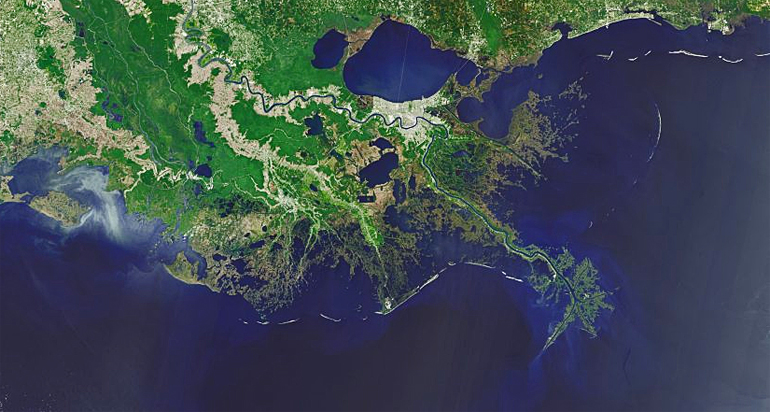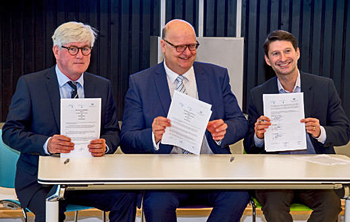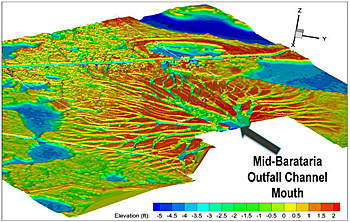The Water Institute and Deltares join forces on global coastal preservation
 Louisiana-based The Water Institute of the Gulf and Dutch-based research institute Deltares announced an agreement to create a powerful scientific collaboration on managing water resources and adapting to rising seas and eroding coasts.
Louisiana-based The Water Institute of the Gulf and Dutch-based research institute Deltares announced an agreement to create a powerful scientific collaboration on managing water resources and adapting to rising seas and eroding coasts.
In the presence of governor John Bel Edwards of Louisiana, the two non-profit institutions signed the agreement in Baton Rouge, USA, on 11 July.
Deltares and The Water Institute have been working together under more limited agreements since The Water Institute was created in 2011.
 The Memorandum of Understanding signed by - from left to right - Toon Segeren (President Deltares USA), Ron Thiemann (Director Deltares) and Justin Ehrenwert (CEO The Water Institute of the Gulf).
The Memorandum of Understanding signed by - from left to right - Toon Segeren (President Deltares USA), Ron Thiemann (Director Deltares) and Justin Ehrenwert (CEO The Water Institute of the Gulf).
Powerful collaboration
The Water Institute of the Gulf was established by leaders in Louisiana to inform and support the state’s 50 billion USD Coastal Master Plan, and to use its science to benefit imperiled coasts across the country and around the world.
Meanwhile, Deltares has provided water management solutions for decades in the Netherlands, and is recognized as the premier scientific institution in adapting to the challenges and opportunities of living with water all over the world.
By leveraging their tools and applied research capabilities, the two institutions want to create a powerful collaboration that will provide integrated, cutting-edge solutions to coastal and water challenges around the world.
Louisiana Coastal Master Plan
Recently the Louisiana state approved the 2017 Coastal Master Plan that includes 125 projects that build or maintain more than 800 square miles of land in the next 50 years.
On the occasion of the signing of the agreement, governor Edwards says his state had reached a critical crossroads for preserving its coastline.
´By combining forces with private research institutions´, Edwards states, `such as The Water Institute of the Gulf and Deltares, this MoU will help us establish a beachhead for mission success.´
 In preparation of the 2017 Coastal master plan, The Institute modelled the land creation as a result of the planned Mid-Barataria sediment diversion, to siphon Mississippi's water into the Barataria basin.
In preparation of the 2017 Coastal master plan, The Institute modelled the land creation as a result of the planned Mid-Barataria sediment diversion, to siphon Mississippi's water into the Barataria basin.
Coastal communities worldwide
President and CEO Justin Ehrenwerth at The Water Institute says to be thrilled to deepen the relationship and pursue global opportunities with Deltares.
`Because of our unique geography and challenges in Louisiana, we have been forced to learn quickly about adaptation for the sake of survival. We have relied for years on the experience of and partnership with our colleagues at Deltares."
´We are thrilled to deepen our relationship with Deltares in the pursuit of opportunities to help communities worldwide', remarked Ehrenwerth.
Growing demand for expertise
Managing director Maarten Smits at Deltares mentions the growing demand for expertise.
‘There is an acceleration of need for global expertise and innovations on water and subsoil’, Smits concluded. ‘We are pleased to partner with The Water Institute, our peer organisation that has done critically important work in a state where we see many parallels, and an organisation with which we have already partnered to do great work.’
This news item was originally published on the websites of Deltares and The Water Institute.
Read also on this website
● Deltares presents composition of flood maps using satellite data through Google Earth Engine, 17 December 2015
● Deltares and Water Institute join forces worldwide research on coastal and river water management, 25 June 2013
● Country: USA
More information
Deltares USA
Silver Spring, MD, USA
+1 301 642 2505
www.deltares.nl/en/usa-canada
The Water Institue of he Gulf
Baton Rouge, LA, USA
+1 225 448 2813
www.thewaterinstitute.org
Rudy Simoneaux, engineering manager for the Coastal protection and restoration authority explains the concept behind the Mid-Barataria sediment diversion project that is part of the Louisiana 2017 Coastal Master Plan.



